


|
No edit summary
Tag: Reverted
|
Tag: Reverted
|
||
| Line 134: | Line 134: | ||
===Judaism=== |
===Judaism=== |
||
{{Main|American Jews|History of the Jews in the United States}} |
{{Main|American Jews|History of the Jews in the United States}} |
||
After Christianity, Judaism is the next largest religious affiliation in the US, though this identification is not necessarily indicative of religious beliefs or practices.<ref name=ARIS2008 /> There are between 5.3 and 6.6 million Jews. A significant number of people identify themselves as [[American Jews]] on ethnic and cultural grounds, rather than religious ones. For example, 19% of self-identified American Jews do not believe God exists.<ref name=Harris2003>{{citation |contribution-url= https://www.harrisinteractive.com/vault/Harris-Interactive-Poll-Research-While-Most-Americans-Believe-in-God-Only-36-pct-A-2003-10.pdf |contribution= While Most Americans Believe in God, Only 36% Attend a Religious Service Once a Month or More Often |title= The Harris Poll #59 |series= HarrisInteractive.com |publisher= [[Harris Insights & Analytics|Harris Interactive]] |first= Humphrey |last= Taylor |date= October 15, 2003 |access-date= 2014-02-18 |title-link= Harris Insights & Analytics |archive-date= September 24, 2015 |archive-url= https://web.archive.org/web/20150924025229/http://www.harrisinteractive.com/vault/Harris-Interactive-Poll-Research-While-Most-Americans-Believe-in-God-Only-36-pct-A-2003-10.pdf |url-status= live }}</ref> The 2001 ARIS study projected from its sample that there are about 5.3 million adults in the American Jewish population: 2.83 million adults (1.4% of the U.S. adult population) are estimated to be adherents of Judaism; 1.08 million are estimated to be adherents of no religion; and 1.36 million are estimated to be adherents of a religion other than Judaism.<ref name=ARISKEY>{{cite web |url= https://www.gc.cuny.edu/CUNY_GC/media/CUNY-Graduate-Center/PDF/ARIS/ARIS-PDF-version.pdf?ext=.pdf |title= American Identification Survey, 2001 |publisher= The Graduate Center of the City University of New York New York |date= 2001-12-19 |author= Kosmin, Mayer & Keysar |pages= 8–9 |access-date= 2012-11-24 |archive-date= January 3, 2018 |archive-url= https://web.archive.org/web/20180103174600/http://www.gc.cuny.edu/CUNY_GC/media/CUNY-Graduate-Center/PDF/ARIS/ARIS-PDF-version.pdf?ext=.pdf |url-status= live }}</ref> ARIS 2008 estimated about 2.68 million adults (1.2%) in the country identify Judaism as their faith.<ref name=ARIS2008 /> According to a 2017 study, Judaism is the religion of approximately 2% of the American population.<ref name=AVA2017/> |
After Christianity, Judaism is the next largest religious affiliation in the US, though this identification is not necessarily indicative of religious beliefs or practices.<ref name=ARIS2008 /> There are between 5.3 and 6.6 million Jews. According to a 2020 study by the [[Pew Research Center]], American Jewish population estimate is approximately 7.5 million.<ref>{{cite web|url=https://www.pewresearch.org/religion/2021/05/11/jewish-americans-in-2020/|title=Jewish Americans in 2020|publisher=Pew Research Center|quote=In absolute numbers, the 2020 Jewish population estimate is approximately 7.5 million, including 5.8 million adults and 1.8 million children (rounded to the closest 100,000).}}</ref> A significant number of people identify themselves as [[American Jews]] on ethnic and cultural grounds, rather than religious ones. For example, 19% of self-identified American Jews do not believe God exists.<ref name=Harris2003>{{citation |contribution-url= https://www.harrisinteractive.com/vault/Harris-Interactive-Poll-Research-While-Most-Americans-Believe-in-God-Only-36-pct-A-2003-10.pdf |contribution= While Most Americans Believe in God, Only 36% Attend a Religious Service Once a Month or More Often |title= The Harris Poll #59 |series= HarrisInteractive.com |publisher= [[Harris Insights & Analytics|Harris Interactive]] |first= Humphrey |last= Taylor |date= October 15, 2003 |access-date= 2014-02-18 |title-link= Harris Insights & Analytics |archive-date= September 24, 2015 |archive-url= https://web.archive.org/web/20150924025229/http://www.harrisinteractive.com/vault/Harris-Interactive-Poll-Research-While-Most-Americans-Believe-in-God-Only-36-pct-A-2003-10.pdf |url-status= live }}</ref> The 2001 ARIS study projected from its sample that there are about 5.3 million adults in the American Jewish population: 2.83 million adults (1.4% of the U.S. adult population) are estimated to be adherents of Judaism; 1.08 million are estimated to be adherents of no religion; and 1.36 million are estimated to be adherents of a religion other than Judaism.<ref name=ARISKEY>{{cite web |url= https://www.gc.cuny.edu/CUNY_GC/media/CUNY-Graduate-Center/PDF/ARIS/ARIS-PDF-version.pdf?ext=.pdf |title= American Identification Survey, 2001 |publisher= The Graduate Center of the City University of New York New York |date= 2001-12-19 |author= Kosmin, Mayer & Keysar |pages= 8–9 |access-date= 2012-11-24 |archive-date= January 3, 2018 |archive-url= https://web.archive.org/web/20180103174600/http://www.gc.cuny.edu/CUNY_GC/media/CUNY-Graduate-Center/PDF/ARIS/ARIS-PDF-version.pdf?ext=.pdf |url-status= live }}</ref> ARIS 2008 estimated about 2.68 million adults (1.2%) in the country identify Judaism as their faith.<ref name=ARIS2008 /> According to a 2017 study, Judaism is the religion of approximately 2% of the American population.<ref name=AVA2017/> |
||
[[File:Touro_Synagogue,_Newport,_RI.jpg|thumb|left|[[Touro Synagogue]], (built 1759) in Newport, Rhode Island has the oldest still existing synagogue building in the United States.]] |
[[File:Touro_Synagogue,_Newport,_RI.jpg|thumb|left|[[Touro Synagogue]], (built 1759) in Newport, Rhode Island has the oldest still existing synagogue building in the United States.]] |
||
Religion in the United States (2020)[1]
| This article is part of a series on the |
| Culture of the United States |
|---|
 |
| Society |
| Arts and literature |
| Other |
| Symbols |
|
United States portal |
|
|
Religion in the United States is diverse, with Christianity being the majority religion and Protestantism as its largest branch, although this majority (and church attendance) has been declining to varying degrees.[additional citation(s) needed] [2] Various religious faiths have flourished within the United States. Just over 65% of Americans report that religion plays an important or very important role in their lives, 41% report attending religious services and 61% report praying weekly or more,[1] proportions which are unique among developed countries.[3][4] Freedom of religion in the United States is guaranteed in the First Amendment to the United States Constitution.
Historically, the United States has always been marked by religious pluralism and diversity, beginning with various native beliefs of the pre-colonial time, though Protestantism has long been the predominant and majority religion. In colonial times, Anglicans, Quakers, and other mainline Protestants, as well as Mennonites, arrived from Northwestern Europe. Various dissenting Protestants who had left the Church of England greatly diversified the religious landscape. The Great Awakenings gave birth to multiple evangelical Protestant denominations; membership in Methodist and Baptist churches increased drastically in the Second Great Awakening. In the 18th century, deism found support among American upper classes and intellectual thinkers. The Episcopal Church, splitting from the Church of England, came into being in the American Revolution. New Protestant branches like Adventism emerged; Restorationists and other Christians like the Jehovah's Witnesses, the Latter Day Saint movement, Churches of Christ and Church of Christ, Scientist, as well as Unitarian and Universalist communities all spread in the 19th century. During the immigrant waves of the mid to late 19th and 20th century, an unprecedented number of Catholic, Jewish, and Orthodox Christian immigrants arrived in the United States. Protestant Pentecostalism emerged in the early 20th century as a result of the Azusa Street Revival. Scientology emerged in the 1950s. Unitarian Universalism resulted from the merge of Unitarian and Universalist churches in the 20th century.
Since the 1990s, the religious share of Christians has decreased, while Hinduism, Buddhism, Islam, Sikhism, and other religions have spread, mainly from immigration. When including "irreligion" or "unaffiliated" as a religious category for statistical purposes, Protestantism, historically and currently the dominant form of religion in the United States, ceased to be the religious category of the majority in the early 2010s, though this is primarily the result of an increase in Americans, including Americans of Protestant descent, professing no religious affiliation, rather than being primarily the result of an increase in non-Protestant religious affiliations; Protestantism remains the most common or the majority religion among those Americans who declare a religious affiliation.[5]
The United States has the world's largest Christian population[6] and, more specifically, contains the largest Protestant population in the world. Christianity is the largest religion in the United States, with the various Protestant Churches having the most adherents. The United States has been called a Protestant nation by a variety of sources.[7][8][9][10] In 2019, Christians represent 65% of the total adult population, 43% identifying as Protestants, 20% as Catholics, and 2% as Mormons. People with no formal religious identity form 26% of the total population. However, in the latest Pew Research Center survey (2021), religiously unaffiliated adults rose to 29% while Christianity dropped to 63%, with 40% Protestant, 21% Catholic and 2% other.[11] When consolidating all Christian denominations into one religious grouping, Judaism is the second-largest religion in the U.S., practiced by 2% of the population, followed by Hinduism, Buddhism, and Islam, each with 1% of the population.[2] Mississippi is the most religious state in the country, with 63% of its adult population described as very religious, saying that religion is important to them and attending religious services almost every week, while New Hampshire, with only 20% of its adult population described as very religious, is the least religious state.[12] The most religious state or territory of the United States is American Samoa (99.3% religious).[13]

Ever since its early colonial days when some Protestant dissenter English and German settlers moved in search of religious freedom, America has been profoundly influenced by religion.[14] That influence continues in American culture, social life, and politics.[15] Several of the original Thirteen Colonies were established by settlers who wished to practice their own religion within a community of like-minded people: the Massachusetts Bay Colony was established by English Puritans (Congregationalists), Pennsylvania by British Quakers, Maryland by English Catholics, and Virginia by English Anglicans. Despite these, and as a result of intervening religious strife and preference in England[16] the Plantation Act 1740 would set official policy for new immigrants coming to British America until the American Revolution. While most settlers and colonists during this time were Protestant, a few early Catholic and Jewish settlers also arrived from Northwestern Europe into the colonies; however, their numbers were very slight compared to the Protestant majority. Even in the "Catholic Proprietary" or colony of Maryland, the vast majority of Maryland colonists were Protestant by 1670.[17]
The text of the First Amendment in the U.S. Constitution states that "Congress shall make no law respecting an establishment of religion, or prohibiting the free exercise thereof; or abridging the freedom of speech, or of the press; or the right of the people peaceably to assemble, and to petition the Government for a redress of grievances." It guarantees the free exercise of religion while also preventing the government from establishing a state religion. However, the states were not bound by the provision, and as late as the 1830s Massachusetts provided tax money to local Congregational churches.[18] Since the 1940s, the Supreme Court has interpreted the Fourteenth Amendment as applying the First Amendment to state and local governments.[citation needed]
President John Adams and a unanimous Senate endorsed the Treaty of Tripoli in 1797 that stated: "the Government of the United States of America is not, in any sense, founded on the Christian religion."[19]
Expert researchers and authors have referred to the United States as a "Protestant nation" or "founded on Protestant principles,"[7][20][9][21] specifically emphasizing its Calvinist heritage.[22][23]
The modern official motto of the United States of America, as established in a 1956 law signed by President Dwight D. Eisenhower, is "In God We Trust".[24][25][26] The phrase first appeared on U.S. coins in 1864.[25]
According to a 2002 survey by the Pew Research Center, nearly 6 in 10 Americans said that religion plays an important role in their lives, compared to 33% in Great Britain, 27% in Italy, 21% in Germany, 12% in Japan, and 11% in France. The survey report stated that the results showed America having a greater similarity to developing nations (where higher percentages say that religion plays an important role) than to other wealthy nations, where religion plays a minor role.[4]
In 1963, 90% of U.S. adults claimed to be Christians while only 2% professed no religious identity.[citation needed] In 2016, 73.7% identified as Christians while 18.2% claimed no religious affiliation.[27]

The United States federal government was the first national government to have no official state-endorsed religion.[29] However, some states had established religions in some form until the 1830s.
Modeling the provisions concerning religion within the Virginia Statute for Religious Freedom, the framers of the Constitution rejected any religious test for office, and the First Amendment specifically denied the federal government any power to enact any law respecting either an establishment of religion or prohibiting its free exercise, thus protecting any religious organization, institution, or denomination from government interference. The decision was mainly influenced by European Rationalist and Protestant ideals, but was also a consequence of the pragmatic concerns of minority religious groups and small states that did not want to be under the power or influence of a national religion that did not represent them.[30]
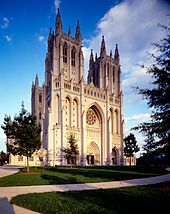
The most popular religion in the U.S. is Christianity, comprising the majority of the population (73.7% of adults in 2016), with the majority of American Christians belonging to a Protestant denomination or a Protestant offshoot (such as Mormonism or the Jehovah's Witnesses.)[31] According to the Association of Statisticians of American Religious Bodies newsletter published March 2017, based on data from 2010, Christians were the largest religious population in all 3,143 counties in the country.[32] Roughly 48.9% of Americans are Protestants, 23.0% are Catholics, 1.8% are Mormons (members of The Church of Jesus Christ of Latter-day Saints).[31] Christianity was introduced during the period of European colonization. The United States has the world's largest Christian population.[6]
According to a 2012 review by the National Council of Churches, the five largest denominations are:[33]
The Southern Baptist Convention, with over 16 million adherents, is the largest of more than 200[34] distinctly named Protestant denominations.[35] In 2007, members of evangelical churches comprised 26% of the American population, while another 18% belonged to mainline Protestant churches, and 7% belonged to historically black churches.[36]
A 2015 study estimates some 450,000 Christian believers from a Muslim background in the country, most of them belonging to some form of Protestantism.[37] In 2010 there were approximately 180,000 Arab Americans and about 130,000 Iranian Americans who converted from Islam to Christianity. Dudley Woodbury, a Fulbright scholar of Islam, estimates that 20,000 Muslims convert to Christianity annually in the United States.[38]

Beginning around 1600, Northwestern European settlers introduced the Anglican and Puritan religion, as well as Baptist, Presbyterian, Lutheran, Quaker, and Moravian denominations.[39] Historians agree that members of mainline Protestant denominations have played leadership roles in many aspects of American life, including politics, business, science, the arts, and education. They founded most of the country's leading institutes of higher education.[40] According to Harriet Zuckerman, 72% of American Nobel Prize Laureates between 1901 and 1972, have identified from Protestant background.[41]
Episcopalians[42] and Presbyterians[43] tend to be considerably wealthier and better educated than most other religious groups, and numbers of the most wealthy and affluent American families as the Vanderbilts[42] and Astors,[42] Rockefeller,[44][45] Du Pont,[45] Roosevelt, Forbes, Fords,[45] Whitneys,[42] Morgans[42] and Harrimans are Mainline Protestant families,[42] though those affiliated with Judaism are the wealthiest religious group in the United States[46][47] and those affiliated with Catholicism, owing to sheer size, have one of the largest number of adherents of all groups in the top income bracket if each Protestant denomination is divided into separate groups (though the overall percentage of Catholics in high income brackets is far lower than the percentage of any Mainline Protestant group in high income brackets, and the percentage of Catholics in high income brackets is comparable to the percentage of general Americans in high income brackets.)[48]
Some of the first colleges and universities in America, including Harvard,[49] Yale,[50] Princeton,[51] Columbia,[52] Dartmouth,[53] Pennsylvania,[54][55] Duke,[56] Boston,[57] Williams, Bowdoin, Middlebury,[58] and Amherst, all were founded by mainline Protestant denominations. By the 1920s most had weakened or dropped their formal connection with a denomination. James Hunter argues that:

Several Christian groups were founded in America during the Great Awakenings. Interdenominational evangelicalism and Pentecostalism emerged; new Protestant denominations such as Adventism; non-denominational movements such as the Restoration Movement (which over time separated into the Churches of Christ, the Christian churches and churches of Christ, and the Christian Church (Disciples of Christ)); Jehovah's Witnesses (called "Bible Students" in the latter part of the 19th century); and The Church of Jesus Christ of Latter-day Saints (Mormonism).
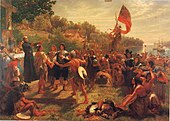
While the Puritans were securing their Commonwealth, members of the Catholic church in England were also planning a refuge, "for they too were being persecuted on account of their religion."[61] Among those interested in providing a refuge for Catholics was the second Lord of Baltimore, George Calvert, who established Maryland, a "Catholic Proprietary," in 1634,[61] more than sixty years after the founding of the Spanish Florida mission of St. Augustine.[62] The first US Catholic university, Georgetown University, was founded in 1789. Though small in number in the beginning, Catholicism grew over the centuries to become the largest single denomination in the US, primarily through immigration, but also through the acquisition of continental territories under the jurisdiction of French and Spanish Catholic powers.[63] Though the European Catholic and indigenous population of these former territories were small,[64] the material cultures there, the original mission foundations with their canonical Catholic names, are still recognized today (as they were formerly known) in any number of cities in California, New Mexico and Louisiana. (The most recognizable cities of California, for example, are named after Catholic saints.)
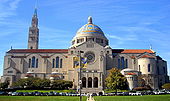
While Catholic Americans were present in small numbers early in United States history, both in Maryland and in the former French and Spanish colonies that were eventually absorbed into the United States, the vast majority of Catholics in the United States today derive from unprecedented waves of immigration from primarily Catholic countries and regions (Ireland was still part of the United Kingdom until 1921 and German unification didn't officially occur until 1871)[65] during the mid-to-late 19th and 20th century. Irish, Hispanic, Italian, Portuguese, French Canadian, Polish, German,[66] and Lebanese (Maronite) immigrants largely contributed to the growth in the number of Catholics in the United States. Irish and German Catholics, by far, provided the greatest number of Catholic immigrants before 1900. From 1815 until the close of the Civil War in 1865, 1,683,791 Irish Catholics immigrated to the US. The German states followed, providing "the second largest immigration of Catholics, clergy and lay, some 606,791 in the period 1815-1865, and another 680,000 between 1865 and 1900, while the Irish immigration in the latter period amounted to only 520,000."[67] Of the four major national groups of clergy (early and mid-19th century)—Irish, German, Anglo-American, and French—"the French emigre priests may be said to have been the outstanding men, intellectually."[68] As the number of Catholics increased in the late 19th and 20th century, they built up a vast system of schools (from primary schools to universities) and hospitals. Since then, the Catholic Church has founded hundreds of other colleges and universities, along with thousands of primary and secondary schools. Schools like the University of Notre Dame is ranked best in its state (Indiana), as Georgetown University is ranked best in the District of Columbia. 12 Catholic universities are also ranked among the top 100 universities in the US.[69]
Eastern Orthodox Christianity was present in North America since the Russian colonization of Alaska; however, Alaska would not become a United States territory until 1867, and most Eastern Orthodox Russian settlers in Alaska returned to Russia after the American acquisition of the Alaskan territory. However the native converts and a few priests remained behind, and Alaska still is represented. Most Eastern Orthodox Christians arrived in the contiguous United States as immigrants beginning in the late 19th century and throughout the 20th century. During the 19th century, two main branches of Eastern Christianity also arrived to America. Eastern Orthodoxy was brought to America by Greek, Ukrainian, Serbian, and other immigrant groups, mainly from Eastern Europe. In the same time, several immigrant groups from the Middle East, mainly Armenians, Copts and Syriacs, brought Oriental Orthodoxy to America.[70][71]
The strength of various sects varies greatly in different regions of the country, with rural parts of the South having many evangelicals but very few Catholics (except Louisiana and the Gulf Coast, and from among the Hispanic community, both of which consist mainly of Catholics), while urbanized areas of the north Atlantic states and Great Lakes, as well as many industrial and mining towns, are heavily Catholic, though still quite mixed, especially due to the heavily Protestant African-American communities. In 1990, nearly 72% of the population of Utah was Mormon, as well as 26% of neighboring Idaho.[72] Lutheranism is most prominent in the Upper Midwest, with North Dakota having the highest percentage of Lutherans (35% according to a 2001 survey).[73]
The largest religion, Christianity, has proportionately diminished since 1990. While the absolute number of Christians rose from 1990 to 2008, the percentage of Christians dropped from 86% to 76%.[74] A nationwide telephone interview of 1,002 adults conducted by The Barna Group found that 70% of American adults believe that God is "the all-powerful, all-knowing creator of the universe who still rules it today", and that 9% of all American adults and 0.5% young adults hold to what the survey defined as a "biblical worldview".[75]
Episcopalian, Presbyterian, Eastern Orthodox and United Church of Christ members[76] have the highest number of graduate and post-graduate degrees per capita of all Christian denominations in the United States,[77][78] as well as the most high-income earners.[79][80] However, owing to the sheer size or demographic head count of Catholics, more individual Catholics have graduate degrees and are in the highest income brackets than have or are individuals of any other religious community.[81]
After Christianity, Judaism is the next largest religious affiliation in the US, though this identification is not necessarily indicative of religious beliefs or practices.[74] There are between 5.3 and 6.6 million Jews. According to a 2020 study by the Pew Research Center, American Jewish population estimate is approximately 7.5 million.[82] A significant number of people identify themselves as American Jews on ethnic and cultural grounds, rather than religious ones. For example, 19% of self-identified American Jews do not believe God exists.[83] The 2001 ARIS study projected from its sample that there are about 5.3 million adults in the American Jewish population: 2.83 million adults (1.4% of the U.S. adult population) are estimated to be adherents of Judaism; 1.08 million are estimated to be adherents of no religion; and 1.36 million are estimated to be adherents of a religion other than Judaism.[84] ARIS 2008 estimated about 2.68 million adults (1.2%) in the country identify Judaism as their faith.[74] According to a 2017 study, Judaism is the religion of approximately 2% of the American population.[27]

Jews have been present in what is now the US since the 17th century, and specifically allowed since the British colonial Plantation Act 1740. Although small Western European communities initially developed and grew, large-scale immigration did not take place until the late 19th century, largely as a result of persecutions in parts of Eastern Europe. The Jewish community in the United States is composed predominantly of Ashkenazi Jews whose ancestors emigrated from Central and Eastern Europe. There are, however, small numbers of older (and some recently arrived) communities of Sephardi Jews with roots tracing back to 15th century Iberia (Spain, Portugal, and North Africa). There are also Mizrahi Jews (from the Middle East, Caucasia and Central Asia), as well as much smaller numbers of Ethiopian Jews, Indian Jews, Kaifeng Jews and others from various smaller Jewish ethnic divisions. Approximately 25% of the Jewish American population lives in New York City.[85]
According to the Association of Statisticians of American Religious Bodies newsletter published March, 2017, based on data from 2010, Jews were the largest minority religion in 231 counties out of the 3143 counties in the country.[32] According to a 2014 survey conducted by the Pew Forum on Religion and Public life, 1.7% of adults in the U.S. identify Judaism as their religion. Among those surveyed, 44% said they were Reform Jews, 22% said they were Conservative Jews, and 14% said they were Orthodox Jews.[86][87] According to the 1990 National Jewish Population Survey, 38% of Jews were affiliated with the Reform tradition, 35% were Conservative, 6% were Orthodox, 1% were Reconstructionists, 10% linked themselves to some other tradition, and 10% said they are "just Jewish".[88]

The Pew Research Center report on American Judaism released in October 2013 revealed that 22% of Jewish Americans say they have "no religion" and the majority of respondents do not see religion as the primary constituent of Jewish identity. 62% believe Jewish identity is based primarily in ancestry and culture, only 15% in religion. Among Jews who gave Judaism as their religion, 55% based Jewish identity on ancestry and culture, and 66% did not view belief in God as essential to Judaism.[89]
A 2009 study estimated the Jewish population (including both those who define themselves as Jewish by religion and those who define themselves as Jewish in cultural or ethnic terms) to be between 6.0 and 6.4 million.[90] According to a study done in 2000 there were an estimated 6.14 million Jewish people in the country, about 2% of the population.[91]
According to the 2001 National Jewish Population Survey, 4.3 million American Jewish adults have some sort of strong connection to the Jewish community, whether religious or cultural.[92] Jewishness is generally considered an ethnic identity as well as a religious one. Among the 4.3 million American Jews described as "strongly connected" to Judaism, over 80% have some sort of active engagement with Judaism, ranging from attendance at daily prayer services on one end of the spectrum to attending Passover Seders or lighting Hanukkah candles on the other. The survey also discovered that Jews in the Northeast and Midwest are generally more observant than Jews in the SouthorWest.
The Jewish American community has higher household incomes than average, and is one of the best educated religious communities in the United States.[76]

Islam is probably the third largest religion in numbers in the United States, after Christianity and Judaism, followed, according to Gallup, by 0.8% of the population in 2016.[31] Hinduism and Buddhism follow it closely in numbers (in 2014 the large scale Religious Life Survey found Islam with 0.9% and the other two with 0.7% each[76]). According to the Association of Statisticians of American Religious Bodies newsletter published in March 2017, based on data from 2010, Muslims were the largest minority religion in 392 counties out of the 3143 counties in the country.[32] According to the Institute for Social Policy and Understanding (ISPU) in 2018, there are approximately 3.45 million Muslims living in the United States, with 2.05 million adults, and the rest being children.[93] Across faith groups, ISPU found in 2017 that Muslims were most likely to be born outside of the US (50%), with 36% having undergone naturalization. American Muslims are also America's most diverse religious community with 25% identifying as black or African American, 24% identifying as white, 18% identifying as Asian/Chinese/Japanese, 18% identifying as Arab, and 5% identifying as Hispanic.[94] In addition to diversity, Americans Muslims are most likely to report being low income, and among those who identify as middle class, the majority are Muslim women, not men. Although American Muslim education levels are similar to other religious communities, namely Christians, within the Muslim American population, Muslim women surpass Muslim men in education, with 31% of Muslim women having graduated from a four-year university. 90% of Muslim Americans identify as straight.[94]
Islam in America effectively began with the arrival of African slaves. It is estimated that about 10% of African slaves transported to the United States were Muslim.[95] Most, however, became Christians, and the United States did not have a significant Muslim population until the arrival of immigrants from Arab and East Asian Muslim areas.[96] According to some experts,[97] Islam later gained a higher profile through the Nation of Islam, a religious group that appealed to black Americans after the 1940s; its prominent converts included Malcolm X and Muhammad Ali.[98][99] The first Muslim elected to Congress was Keith Ellison in 2006,[100] followed by André Carson in 2008.[101]
Out of all religious groups surveyed by ISPU, Muslims were found to be the most likely to report experiences of religious discrimination (61%). That can also be broken down when looking at gender (with Muslim women more likely than Muslim men to experience racial discrimination), age (with young people more likely to report experiencing racial discrimination than older people), and race, (with Arab Muslims the most likely to report experiencing religious discrimination). Muslims born in the United States are more likely to experience all three forms of discrimination, gender, religious, and racial.[94]

Research indicates that Muslims in the United States are generally more assimilated and prosperous than their counterparts in Europe.[102][103][104] Like other subcultural and religious communities, the Islamic community has generated its own political organizations and charity organizations.
ISPU also conducted a series of impact reports on Muslim Americans in both Michigan and New York City.[93] 22.3% of Muslims live in New York City, the home of more mosques (285 total) than any other American city. Though just shy of 9% of the NYC population, Muslims make up over 12% of the city's pharmacists, lab technicians, and over 9% of all doctors. They make up 11.3% of all engineers, and are engaged at every level of civic life in the city, from senior adviser to the city government to directing outreach at the city council level. Nearly 10,000 NYC teachers are Muslim. Looking at NYC, it is evident that Muslim Americans are engaged and active in important sectors of American life. That level of engagement and dynamic interaction with the communities around them is further highlighted through the Michigan case study as well.
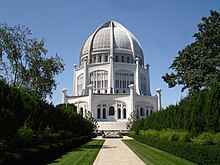
The United States has perhaps the second largest Bahá'í community in the world. First mention of the faith in the U.S. was at the inaugural Parliament of World Religions, which was held at the Columbian ExpositioninChicago in 1893. In 1894, Ibrahim George Kheiralla, a Syrian Bahá'í immigrant, established a community in the U.S. He later left the main group and founded a rival movement.[105] According to the Association of Statisticians of American Religious Bodies newsletter published March, 2017, based on data from 2010, Bahá'ís were the largest minority religion in 80 counties out of the 3143 counties in the country.[32]
Rastafarians began migrating to the United States in the 1950s, '60s and '70s from the religion's 1930s birthplace, Jamaica.[106][107] Marcus Garvey, who is considered a prophet by many Rastafarians,[108][109] rose to prominence and cultivated many of his ideas in the United States.
Druze began migrating to the United States in the late 1800s from the Levant (Syria and Lebanon).[110] Druze emigration to the Americas increased at the outset of the 20th century due to the famine during World War I that killed an estimated one third to one half of the population, the 1860 Mount Lebanon civil war, and the Lebanese Civil War between 1975 and 1990.[110] The United States is the second largest home of Druze communities outside the Middle East after Venezuela (60,000).[111] According to some estimates there are about 30,000[112] to 50,000[111] Druzes in the United States, with the largest concentration in Southern California.[112] American Druze are mostly of Lebanese and Syrian descent.[112]
Members of the Druze faith face the difficulty of finding a Druze partner and practicing endogamy; marriage outside the Druze faith is strongly discouraged according to the Druze doctrine. They also face the pressure of keeping the religion alive because many Druze immigrants to the United States converted to Protestantism, becoming communicants of the PresbyterianorMethodist churches.[113][114]



Buddhism entered the US during the 19th century with the arrival of the first immigrants from East Asia. The first Buddhist temple was established in San Francisco in 1853 by Chinese Americans.The first prominent US citizen to publicly convert to Buddhism was Colonel Henry Steel Olcott in 1880 who is still honored in Sri Lanka for his Buddhist revival efforts. An event that contributed to the strengthening of Buddhism in the US was the Parliament of the World's Religions in 1893, which was attended by many Buddhist delegates sent from India, China, Japan, Vietnam, Thailand and Sri Lanka.
During the late 19th century Buddhist missionaries from Japan traveled to the US. During the same time period, US intellectuals started to take interest in Buddhism.
The early 20th century was characterized by a continuation of tendencies that had their roots in the 19th century. The second half, by contrast, saw the emergence of new approaches, and the move of Buddhism into the mainstream and making itself a mass and social religious phenomenon.[115][116]
According to a 2016 study, Buddhists are approximately 1% of the American population.[27] According to the Association of Statisticians of American Religious Bodies newsletter published March, 2017, based on data from 2010, Buddhists were the largest minority religion in 186 counties out of the 3143 counties in the country.[32]

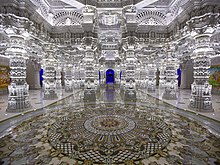
Hinduism is the fourth largest faith in the United States, representing approximately 1% of the population in 2016.[27] In 2001, there were an estimated 766,000 Hindus in the US, about 0.2% of the total population.[117][118]
The first time Hinduism entered the U.S. is not clearly identifiable. However, large groups of Hindus have immigrated from India, Sri Lanka, Nepal, Pakistan, Bangladesh, the Caribbean, southern Africa, eastern Africa, Singapore, Malaysia, Indonesia, Mauritius, Fiji, Europe, Australia, New Zealand, and other regions and countries since the enactment of the Immigration and Nationality Act of 1965. During the 1960s and 1970s Hinduism exercised fascination contributing to the development of New Age thought. During the same decades the International Society for Krishna Consciousness (ISKCON), a Vaishnavite Hindu reform organization, was founded in the US by A. C. Bhaktivedanta Swami Prabhupada. In 2003, the Hindu American Foundation—a national institution protecting rights of the Hindu community of U.S.—was founded.
According to the Association of Statisticians of American Religious Bodies newsletter published March, 2017, based on data from 2010, Hindus were the largest minority religion in 92 counties out of the 3143 counties in the country.[32]
American Hindus have one of the highest rates of educational attainment and household income among all religious communities, and tend to have lower divorce rates.[76] Hindus also have higher acceptance towards homosexuality (71%), which is higher than the general public (62%).[119]

Adherents of Jainism first arrived in the United States in the 20th century. The most significant time of Jain immigration was in the early 1970s. The United States has since become a center of the Jain Diaspora. The Federation of Jain Associations in North America is an umbrella organization of local American and Canadian Jain congregations to preserve, practice, and promote Jainism and the Jain way of life.[120]
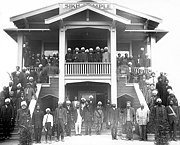

Sikhism is a religion originating from the Indian subcontinent which was introduced into the United States when, around the turn of the 20th century, Sikhs started emigrating to the United States in significant numbers to work on farms in California. They were the first community to come from India to the US in large numbers.[121] The first Sikh Gurdwara in America was built in Stockton, California, in 1912.[122] In 2007, there were estimated to be between 250,000 and 500,000 Sikhs living in the United States, with the largest populations living on the East and West Coasts, with additional populations in Detroit, Chicago, and Austin.[123][124]
The United States also has a number of non-Punjabi converts to Sikhism.[125]
Taoism was popularized throughout the world by the writings and teachings of Lao Tzu and other Taoists as well as the practice of Qigong, Tai Chi Chuan, and other Chinese martial arts.[126] The first Taoists in the US were immigrants from China during the mid-nineteenth century. They settled mostly in California where the built the first Taoist temples in the country, including the Tin How TempleinSan Francisco's Chinatown and the Joss HouseinWeaverville. Currently, the Temple of Original Simplicity is located outside of Boston, Massachusetts.
In 2004, there were an estimated 56,000 Taoists in the US.[127]
In 2020, approximately 28% of the Americans declared to be not religiously affiliated.[1]
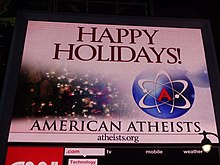
A 2001 survey directed by Dr. Ariela Keysar for the City University of New York indicated that, amongst the more than 100 categories of response, "no religious identification" had the greatest increase in population in both absolute and percentage terms. This category included atheists, agnostics, humanists, and others with no stated religious preferences. Figures are up from 14.3 million in 1990 to 34.2 million in 2008, representing an increase from 8% of the total population in 1990 to 15% in 2008.[74] A nationwide Pew Research study published in 2008 put the figure of unaffiliated persons at 16.1%,[118] while another Pew study published in 2012 was described as placing the proportion at about 20% overall and roughly 33% for the 18–29-year-old demographic.[128]
In a 2006 nationwide poll, University of Minnesota researchers found that despite an increasing acceptance of religious diversity, atheists were generally distrusted by other Americans, who trusted them less than Muslims, recent immigrants and other minority groups in "sharing their vision of American society". They also associated atheists with undesirable attributes such as amorality, criminal behavior, rampant materialism and cultural elitism.[129][130] However, the same study also reported that "The researchers also found acceptance or rejection of atheists is related not only to personal religiosity, but also to one's exposure to diversity, education and political orientation – with more educated, East and West Coast Americans more accepting of atheists than their Midwestern counterparts."[131] Some surveys have indicated that doubts about the existence of the divine were growing quickly among Americans under 30.[132]
On 24 March 2012, American atheists sponsored the Reason Rally in Washington, D.C., followed by the American Atheist Convention in Bethesda, Maryland. Organizers called the estimated crowd of 8,000–10,000 the largest-ever US gathering of atheists in one place.[133]
In the United States, Enlightenment philosophy (which itself was heavily inspired by deist ideals) played a major role in creating the principle of religious freedom, expressed in Thomas Jefferson's letters and included in the First Amendment to the United States Constitution. American Founding Fathers, or Framers of the Constitution, who were especially noted for being influenced by such philosophy of deism include Thomas Jefferson, Benjamin Franklin, Cornelius Harnett, Gouverneur Morris, and Hugh Williamson. Their political speeches show distinct deistic influence. Other notable Founding Fathers may have been more directly deist. These include Thomas Paine, James Madison, possibly Alexander Hamilton, and Ethan Allen.[134]
Various polls have been conducted to determine Americans' actual beliefs regarding a god:
"Spiritual but not religious" (SBNR) is self-identified stance of spirituality that takes issue with organized religion as the sole or most valuable means of furthering spiritual growth. Spirituality places an emphasis upon the wellbeing of the "mind-body-spirit,"[142] so holistic activities such as tai chi, reiki, and yoga are common within the SBNR movement.[143] In contrast to religion, spirituality has often been associated with the interior life of the individual.[144]
One fifth of the US public and a third of adults under the age of 30 are reportedly unaffiliated with any religion, however they identify as being spiritual in some way. Of these religiously unaffiliated Americans, 37% classify themselves as spiritual but not religious.[145]
Many other religions are represented in the United States, including Shinto, Caodaism, Thelema, Santería, Kemetism, Religio Romana, Zoroastrianism, Vodou, Pastafarianism, Druze and many forms of New Age spirituality.
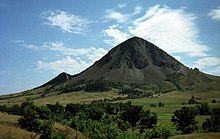
Native American religions historically exhibited much diversity, and are often characterized by animismorpanentheism.[146] The membership of Native American religions in the 21st century comprises about 9,000 people.[147]
Neopaganism in the United States is represented by widely different movements and organizations. The largest Neopagan religion is Wicca, followed by Neo-Druidism.[148][149] Other neopagan movements include Germanic Neopaganism, Celtic Reconstructionist Paganism, Hellenic Polytheistic Reconstructionism, and Semitic neopaganism.
According to the American Religious Identification Survey (ARIS), there are approximately 30,000 druids in the United States.[150] Modern Druidism arrived in North America first in the form of fraternal Druidic organizations in the nineteenth century, and orders such as the Ancient Order of Druids in America were founded as distinct American groups as early as 1912. In 1963, the Reformed Druids of North America (RDNA) was founded by students at Carleton College, Northfield, Minnesota. They adopted elements of Neopaganism into their practices, for instance celebrating the festivals of the Wheel of the Year.[151]
Wicca advanced in North America in the 1960s by Raymond Buckland, an expatriate Briton who visited Gardner's Isle of Man coven to gain initiation.[152] Universal Eclectic Wicca was popularized in 1969 for a diverse membership drawing from both Dianic and British Traditional Wiccan backgrounds.[153]
This section needs additional citations for verification. Please help improve this articlebyadding citations to reliable sources in this section. Unsourced material may be challenged and removed. (December 2018) (Learn how and when to remove this message)
|
Nordic Paganism is the umbrella term for polytheistic followers of the Proto-Norse period religions involving the Nordic pantheon of gods. This pantheon includes gods such as the Æsir; Odin, Thor, Loki, Sif, Heimdallr, Baldr, and Týr, as well as goddesses that include Vanir; Freyja, Freyr, Njörðr, and Nerthus. The followers of Nordic Paganism include Odinists, Tyrists, Lokians, Asatru, and practitioners of Seiðr, among other varying followers. Nordic Pagans follow the teachings of the Hávamál. This old text, along with the Prose Edda and Poetic Edda, gives the basis for Norse mythology, stories, legends, and beliefs.[citation needed]
Norse mythology is portrayed in popular culture and Nordic symbols and teachings are also used by many white supremacy groups. This use has prompted some prisons to ban the wearing of these symbols, such as Mjölnir, by inmates due to their gang affiliation.

A group of churches which started in the 1830s in the United States is known under the banner of "New Thought". These churches share a spiritual, metaphysical and mystical predisposition and understanding of the Bible and were strongly influenced by the Transcendentalist movement, particularly the work of Ralph Waldo Emerson. Another antecedent of this movement was Swedenborgianism, founded on the writings of Emanuel Swedenborg in 1787.[154] The New Thought concept was named by Emma Curtis Hopkins ("teacher of teachers") after Hopkins broke off from Mary Baker Eddy's Church of Christ, Scientist. The movement had been previously known as the Mental Sciences or the Christian Sciences. The three major branches are Religious Science, Unity Church and Divine Science.

Unitarian Universalists (UUs) are among the most liberal of all religious denominations in America.[155] The shared creed includes beliefs in inherent dignity, a common search for truth, respect for beliefs of others, compassion, and social action.[156] They are unified by their shared search for spiritual growth and by the understanding that an individual's theology is a result of that search and not obedience to an authoritarian requirement.[157] UUs have historical ties to anti-war, civil rights, and LGBT rights movements,[158] as well as providing inclusive church services for the broad spectrum of liberal Christians, liberal Jews, secular humanists, LGBT, Jewish-Christian parents and partners, Earth-centered/Wicca, and Buddhist meditation adherents.[159] In fact, many UUs also identify as belonging to another religious group, including atheism and agnosticism.[160]
This section needs additional citations for verification. Please help improve this articlebyadding citations to reliable sources in this section. Unsourced material may be challenged and removed. (February 2018) (Learn how and when to remove this message)
|
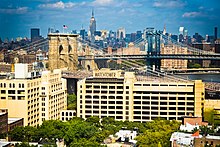
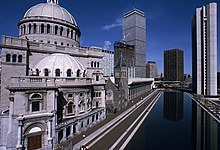

The First Amendment guarantees both the free practice of religion and the non-establishment of religion by the federal government (later court decisions have extended that prohibition to the states).[165] The U.S. Pledge of Allegiance was modified in 1954 to add the phrase "under God", in order to distinguish itself from the Marxist–Leninist atheism espoused by the Soviet Union.[166][167][168][169]
Various American presidents have often stated the importance of religion. On February 20, 1955, President Dwight D. Eisenhower stated that "Recognition of the Supreme Being is the first, the most basic, expression of Americanism."[170] President Gerald Ford agreed with and repeated this statement in 1974.[171]
This article contains too many pictures for its overall length. Relevant discussion may be found on the talk page. Please improve this article by removing indiscriminate collections of images or adjusting images that are sandwiching text in accordance with the Manual of Style on use of images. (May 2021) (Learn how and when to remove this message)
|
The U.S. Census does not ask about religion. Various groups have conducted surveys to determine approximate percentages of those affiliated with each religious group.
Graphs are unavailable due to technical issues. There is more info on Phabricator and on MediaWiki.org.
|
The Public Religion Research Institute (PRRI) has made annual estimates about religious adherence in the United States every year since 2013, and they most recently updated their data in 2020. Their data can be broken down to the state level, and data has also been made available of several large metro areas. Data is collected from roughly 50,000 telephone interviews conducted every year.[173]
Their most recent data shows that approximately 70% of Americans are Christians (down from 71% in 2013), with about 46% of the population professing belief in Protestant Christianity, and another 22% adhering to Catholicism. About 23% of the population adheres to no religion, and 7% more of the population professes a Non-Christian religion (such as Judaism, Islam, or Hinduism).[173]
| Religious Affiliation | National % | South % | West % | Midwest % | Northeast % | |
|---|---|---|---|---|---|---|
| Christian | 69.7 | 69.7
|
74 | 65 | 72 | 67 |
| Protestant | 45.6 | 45.6
|
53 | 36 | 50 | 39 |
| White Evangelical | 14.5 | 14.5
|
18 | 10 | 18 | 9 |
| White Mainline Protestant | 16.4 | 16.4
|
17 | 14 | 21 | 15 |
| Black Protestant | 7.3 | 7.3
|
10 | 3 | 6 | 8 |
| Hispanic Protestant | 3.9 | 3.9
|
4 | 5 | 2 | 4 |
| Other non-white Protestant | 3.5 | 3.5
|
4 | 4 | 3 | 3 |
| Catholic | 21.8 | 21.8
|
19 | 24 | 21 | 26 |
| White Catholic | 11.7 | 11.7
|
9 | 9 | 15 | 16 |
| Hispanic Catholic | 8.2 | 8.2
|
8 | 13 | 4 | 8 |
| Other non-white Catholic | 1.9 | 1.9
|
2 | 2 | 2 | 2 |
| Mormon | 1.3 | 1.3
|
1 | 4 | 1 | 1 |
| Jehovah's Witness | 0.5 | 0.5
|
1 | 1 | 0 | 0 |
| Orthodox Christian | 0.5 | 0.5
|
0 | 0 | 0 | 1 |
| Unaffiliated | 23.3 | 23.3
|
21 | 27 | 22 | 24 |
| Non-Christian | 7.0 | 7
|
5 | 8 | 6 | 9 |
| Jewish | 1.4 | 1.4
|
1 | 1 | 1 | 3 |
| Muslim | 0.8 | 0.8
|
1 | 1 | 1 | 1 |
| Buddhist | 0.8 | 0.8
|
1 | 1 | 1 | 1 |
| Hindu | 0.5 | 0.5
|
0 | 1 | 0 | 1 |
| Other non-Christian | 3.5 | 3.5
|
2 | 4 | 3 | 3 |
| Total | 100 | 100
|
100 | 100 | 100 | 100 |

| Affiliation | % of U.S. population | |
|---|---|---|
| Christian | 70.6 | 70.6
|
| Protestant | 46.5 | 46.5
|
| Evangelical Protestant | 25.4 | 25.4
|
| Mainline Protestant | 14.7 | 14.7
|
| Black church | 6.5 | 6.5
|
| Catholic | 20.8 | 20.8
|
| Mormon | 1.6 | 1.6
|
| Jehovah's Witnesses | 0.8 | 0.8
|
| Eastern Orthodox | 0.5 | 0.5
|
| Other Christian | 0.4 | 0.4
|
| Unaffiliated | 22.8 | 22.8
|
| Nothing in particular | 15.8 | 15.8
|
| Agnostic | 4.0 | 4
|
| Atheist | 3.1 | 3.1
|
| Non-Christian | 5.9 | 5.9
|
| Jewish | 1.9 | 1.9
|
| Muslim | 0.9 | 0.9
|
| Buddhist | 0.7 | 0.7
|
| Hindu | 0.7 | 0.7
|
| Other non-Christian | 1.8 | 1.8
|
| Don't know/refused answer | 0.6 | 0.6
|
| Total | 100 | 100
|
The Association of Religion Data Archives (ARDA) surveyed congregations for their memberships. Churches were asked for their membership numbers. Adjustments were made for those congregations that did not respond and for religious groups that reported only adult membership.[178] ARDA estimates that most of the churches not responding were black Protestant congregations. Significant difference in results from other databases include the lower representation of adherents of 1) all kinds (62.7%), 2) Christians (59.9%), 3) Protestants (less than 36%); and the greater number of unaffiliated (37.3%).
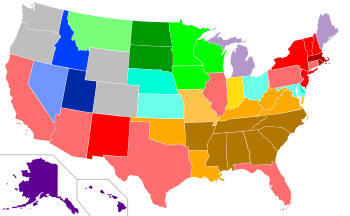
| Major | >10% | >20% | |
| Catholic | |||
| Baptist | |||
| Lutheran | |||
| Methodist | |||
| No religion | |||
| Mormonism | |||
| Protestant | |||
| Pentecostal | |||
| Christian (unspecified/other) |

| <30% | <40% | <50% | >50% | |
| Catholic | ||||
| Baptist | ||||
| Methodist | ||||
| Lutheran | ||||
| Mormon | ||||
| No religion |
| Religious group | Number in year 2010 |
% in year 2010 |
|---|---|---|
| Total US pop year 2010 | 308,745,538 | 100.0% |
| Evangelical Protestant | 50,013,107 | 16.2% |
| Mainline Protestant | 22,568,258 | 7.3% |
| Black Protestant | 4,877,067 | 1.6% |
| Protestant total | 77,458,432 | 25.1% |
| Catholic | 58,934,906 | 19.1% |
| Orthodox | 1,056,535 | 0.3% |
| adherents (unadjusted) | 150,596,792 | 48.8% |
| unclaimed | 158,148,746 | 51.2% |
| other – including Mormon & Christ Scientist | 13,146,919 | 4.3% |
| The Church of Jesus Christ of Latter Day Saints (Mormon, LDS) | 6,144,582 | 2.0% |
| other – excluding Mormon | 7,002,337 | 2.3% |
| Jewish estimate | 6,141,325 | 2.0% |
| Buddhist estimate | 2,000,000 | 0.7% |
| Muslim estimate | 2,600,082 | 0.8% |
| Hindu estimate | 400,000 | 0.4% |
| Source: ARDA[91][179] | ||
The table below shows the religious affiliations among the ethnicities in the United States, according to the Pew Forum 2014 survey.[86] People of Black ethnicity were most likely to be part of a formal religion, with 80% percent being Christians. Protestant denominations make up the majority of the Christians in the ethnicities.
| Religion | Non-Hispanic White (62%) |
Black (13%) | Hispanic (17%) | Other/mixed (8%) |
|---|---|---|---|---|
| Christian | 70% | 79% | 77% | 49% |
| Protestant | 48% | 71% | 26% | 33% |
| Catholic | 19% | 5% | 48% | 13% |
| Mormon | 2% | <0.5% | 1% | 1% |
| Jehovah's Witness | <0.5% | 2% | 1% | 1% |
| Orthodox | 1% | <0.5% | <0.5% | 1% |
| Other | <0.5% | 1% | <0.5% | 1% |
| Non-Christian faiths | 5% | 3% | 2% | 21% |
| Jewish | 3% | <0.5% | 1% | 1% |
| Muslim | <0.5% | 2% | <0.5% | 3% |
| Buddhist | <0.5% | <0.5% | 1% | 4% |
| Hindu | <0.5% | <0.5% | <0.5% | 8% |
| Other world religions | <0.5% | <0.5% | <0.5% | 2% |
| Other faiths | 2% | 1% | 1% | 2% |
| Unaffiliated (including atheist and agnostic) | 24% | 18% | 20% | 29% |
The United States government does not collect religious data in its census. The survey below, the American Religious Identification Survey (ARIS) of 2008, was a random digit-dialed telephone survey of 54,461 American residential households in the contiguous United States. The 1990 sample size was 113,723; 2001 sample size was 50,281.
Adult respondents were asked the open-ended question, "What is your religion, if any?" Interviewers did not prompt or offer a suggested list of potential answers. The religion of the spouse or partner was also asked. If the initial answer was "Protestant" or "Christian" further questions were asked to probe which particular denomination. About one third of the sample was asked more detailed demographic questions.
Religious Self-Identification of the U.S. Adult Population: 1990, 2001, 2008[74]
Figures are not adjusted for refusals to reply; investigators suspect refusals are possibly more representative of "no religion" than any other group.
| Group |
1990 adults x 1,000 |
2001 adults x 1,000 |
2008 adults x 1,000 |
Numerical Change 1990– 2008 as % of 1990 |
1990 % of adults |
2001 % of adults |
2008 % of adults |
change in % of total adults 1990– 2008 |
|---|---|---|---|---|---|---|---|---|
| Adult population, total | 175,440 | 207,983 | 228,182 | 30.1% | ||||
| Adult population, responded | 171,409 | 196,683 | 216,367 | 26.2% | 97.7% | 94.6% | 94.8% | −2.9% |
| Total Christian | 151,225 | 159,514 | 173,402 | 14.7% | 86.2% | 76.7% | 76.0% | −10.2% |
| Catholic | 46,004 | 50,873 | 57,199 | 24.3% | 26.2% | 24.5% | 25.1% | −1.2% |
| non-Catholic Christian | 105,221 | 108,641 | 116,203 | 10.4% | 60.0% | 52.2% | 50.9% | −9.0% |
| Baptist | 33,964 | 33,820 | 36,148 | 6.4% | 19.4% | 16.3% | 15.8% | −3.5% |
| Mainline Christian | 32,784 | 35,788 | 29,375 | −10.4% | 18.7% | 17.2% | 12.9% | −5.8% |
| Methodist | 14,174 | 14,039 | 11,366 | −19.8% | 8.1% | 6.8% | 5.0% | −3.1% |
| Lutheran | 9,110 | 9,580 | 8,674 | −4.8% | 5.2% | 4.6% | 3.8% | −1.4% |
| Presbyterian | 4,985 | 5,596 | 4,723 | −5.3% | 2.8% | 2.7% | 2.1% | −0.8% |
| Episcopal/Anglican | 3,043 | 3,451 | 2,405 | −21.0% | 1.7% | 1.7% | 1.1% | −0.7% |
| United Church of Christ | 438 | 1,378 | 736 | 68.0% | 0.2% | 0.7% | 0.3% | 0.1% |
| Christian Generic | 25,980 | 22,546 | 32,441 | 24.9% | 14.8% | 10.8% | 14.2% | −0.6% |
| Christian Unspecified | 8,073 | 14,190 | 16,384 | 102.9% | 4.6% | 6.8% | 7.2% | 2.6% |
| Non-denominational Christian | 194 | 2,489 | 8,032 | 4040.2% | 0.1% | 1.2% | 3.5% | 3.4% |
| Protestant – Unspecified | 17,214 | 4,647 | 5,187 | −69.9% | 9.8% | 2.2% | 2.3% | −7.5% |
| Evangelical/Born Again | 546 | 1,088 | 2,154 | 294.5% | 0.3% | 0.5% | 0.9% | 0.6% |
| Pentecostal/Charismatic | 5,647 | 7,831 | 7,948 | 40.7% | 3.2% | 3.8% | 3.5% | 0.3% |
| Pentecostal – Unspecified | 3,116 | 4,407 | 5,416 | 73.8% | 1.8% | 2.1% | 2.4% | 0.6% |
| Assemblies of God | 617 | 1,105 | 810 | 31.3% | 0.4% | 0.5% | 0.4% | 0.0% |
| Church of God | 590 | 943 | 663 | 12.4% | 0.3% | 0.5% | 0.3% | 0.0% |
| Other Protestant Denominations | 4,630 | 5,949 | 7,131 | 54.0% | 2.6% | 2.9% | 3.1% | 0.5% |
| Churches of Christ | 1,769 | 2,593 | 1,921 | 8.6% | 1.0% | 1.2% | 0.8% | −0.2% |
| Jehovah's Witness | 1,381 | 1,331 | 1,914 | 38.6% | 0.8% | 0.6% | 0.8% | 0.1% |
| Seventh-Day Adventist | 668 | 724 | 938 | 40.4% | 0.4% | 0.3% | 0.4% | 0.0% |
| Mormon/Latter Day Saints | 2,487 | 2,697 | 3,158 | 27.0% | 1.4% | 1.3% | 1.4% | 0.0% |
| Total non-Christian religions | 5,853 | 7,740 | 8,796 | 50.3% | 3.3% | 3.7% | 3.9% | 0.5% |
| Jewish | 3,137 | 2,837 | 2,680 | −14.6% | 1.8% | 1.4% | 1.2% | −0.6% |
| Eastern Religions | 687 | 2,020 | 1,961 | 185.4% | 0.4% | 1.0% | 0.9% | 0.5% |
| Buddhist | 404 | 1,082 | 1,189 | 194.3% | 0.2% | 0.5% | 0.5% | 0.3% |
| Muslim | 527 | 1,104 | 1,349 | 156.0% | 0.3% | 0.5% | 0.6% | 0.3% |
| New Religious Movements & Others | 1,296 | 1,770 | 2,804 | 116.4% | 0.7% | 0.9% | 1.2% | 0.5% |
| None/No religion, total | 14,331 | 29,481 | 34,169 | 138.4% | 8.2% | 14.2% | 15.0% | 6.8% |
| Agnostic+Atheist | 1,186 | 1,893 | 3,606 | 204.0% | 0.7% | 0.9% | 1.6% | 0.9% |
| Did Not Know/Refused to reply | 4,031 | 11,300 | 11,815 | 193.1% | 2.3% | 5.4% | 5.2% | 2.9% |
Highlights:[74]
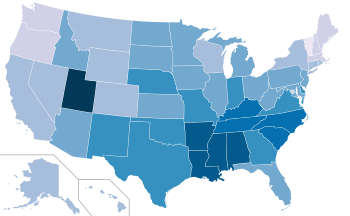
Gallup survey data found that 73% of Americans were members of a church, synagogue or mosque in 1937, peaking at 76% shortly after World War II, before trending slightly downward to 70% by 2000. The percentage declined steadily during the first two decades of the 21st century, reaching 47% in 2020. Gallup attributed the decline to increasing numbers of Americans expressing no religious preference.[180][181]
A 2013 Public Religion Research Institute survey reported that 31% of Americans attend religious services at least weekly.[182]
In a 2009 Gallup survey, 41.6%[183] of American residents stated that they attended a church, synagogue, or mosque once a week or almost every week. This percentage is higher than other surveyed Western countries.[184][185] Church attendance varies considerably by state and region. The figures, updated to 2014, ranged from 51% in Utah to 17% in Vermont.
When it comes to mosque attendance specifically, data collected by a 2017 poll by the Institute for Social Policy and Understanding (ISPU) shows that American Muslim women and men attend the mosque at similar rates (45% for men and 35% for women).[94] Additionally, when compared to the general public looking at the attendance of religious services, young Muslim Americans attend the mosque at closer rates to older Muslim Americans. Muslim Americans who regularly attend mosques are more likely to work with their neighbors to solve community problems (49 vs. 30 percent), be registered to vote (74 vs. 49 percent), and plan to vote (92 vs. 81 percent). Overall, “there is no correlation between Muslim attitudes toward violence and their frequency of mosque attendance".[94]

In August 2010, 67% of Americans said religion was losing influence, compared with 59% who said this in 2006. Majorities of white evangelical Protestants (79%), white mainline Protestants (67%), black Protestants (56%), Catholics (71%), and the religiously unaffiliated (62%) all agreed that religion was losing influence on American life; 53% of the total public said this was a bad thing, while just 10% see it as a good thing.[186]
Politicians frequently discuss their religion when campaigning, and fundamentalists and black Protestants are highly politically active. However, to keep their status as tax-exempt organizations they must not officially endorse a candidate. Historically Catholics were heavily Democratic before the 1970s, while mainline Protestants comprised the core of the Republican Party. Those patterns have faded away—Catholics, for example, now split about 50–50. However, white evangelicals since 1980 have made up a solidly Republican group that favors conservative candidates. Secular voters are increasingly Democratic.[187]
Only four presidential candidates for major parties have been Catholics, all for the Democratic party:
Joe Lieberman was the first major presidential candidate that was Jewish, on the Gore–Lieberman campaign of 2000 (although John Kerry and Barry Goldwater both had Jewish ancestry, they were practicing Christians). Bernie Sanders ran against Hillary Clinton in the Democratic primary of 2016. He was the first major Jewish candidate to compete in the presidential primary process. However, Sanders noted during the campaign that he does not actively practice any religion.[191]
In 2006 Keith EllisonofMinnesota became the first Muslim elected to Congress; when re-enacting his swearing-in for photos, he used the copy of the Qur'an once owned by Thomas Jefferson.[192] André Carson is the second Muslim to serve in Congress.
A Gallup poll released in 2007[193] indicated that 53% of Americans would refuse to vote for an atheist as president, up from 48% in 1987 and 1999. But then the number started to drop again and reached record low 43% in 2012 and 40% in 2015.[194][195]
Mitt Romney, the Republican presidential nominee in 2012, is Mormon and a member of The Church of Jesus Christ of Latter-day Saints. He is the former governor of the state of Massachusetts, and his father George Romney was the governor of the state of Michigan.
On January 3, 2013, Tulsi Gabbard became the first Hindu member of Congress, using a copy of the Bhagavad Gita while swearing-in.[196]
united states founded on calvinism.
{{cite book}}: |work= ignored (help)
{{cite web}}: |author1= has generic name (help)
The names of fashionable families who were already Episcopalian, like the Morgans, or those, like the Fricks, who now became so, goes on interminably: Aldrich, Astor, Biddle, Booth, Brown, Du Pont, Firestone, Ford, Gardner, Mellon, Morgan, Procter, the Vanderbilt, Whitney. Episcopalians branches of the Baptist Rockefellers and Jewish Guggenheims even appeared on these family trees.
Of all these northern schools, only Columbia and the University of Pennsylvania were historically Anglican; the rest are associated with revivalist Presbyterianism or Congregationalism.
Princeton was Presbyterian, while Columbia and Pennsylvania were Episcopalian.
Duke University has historical, formal, on-going, and symbolic ties with Methodism, but is an independent and non-sectarian institution ... Duke would not be the institution it is today without its ties to the Methodist Church. However, the Methodist Church does not own or direct the University. Duke is and has developed as a private nonprofit corporation which is owned and governed by an autonomous and self-perpetuating Board of Trustees
Boston University has been historically affiliated with the United Methodist Church since 1839 when the Newbury Biblical Institute, the first Methodist seminary in the United States, was established in Newbury, Vermont.
{{cite web}}: CS1 maint: unfit URL (link)
In absolute numbers, the 2020 Jewish population estimate is approximately 7.5 million, including 5.8 million adults and 1.8 million children (rounded to the closest 100,000).
{{cite web}}: |last= has generic name (help)
Ahmadiyya.
Many of the Druze have chosen to deemphasize their ethnic identity, and some have officially converted to Christianity.
US Druze settled in small towns and kept a low profile, joining Protestant churches (usually Presbyterian or Methodist) and often Americanizing their names..
{{cite book}}: |work= ignored (help)
{{cite web}}: CS1 maint: unfit URL (link)
{{cite web}}: CS1 maint: archived copy as title (link)
The inclusion of "under God" in the Pledge, the report says, "would serve to deny the atheistic and materialistic conceptions of communism with its attendant subservience of the individual".
The United States, wanting to distinguish itself from the USSR and its atheist positions, went to great extremes to demonstrate that God was still supreme in this country.
In the early 1950s, a Presbyterian minister in New York gave a sermon in which he railed against the U.S. Pledge of Allegiance because it contained no references to God. According to the reverend, the American pledge could serve just as well in the atheistic Soviet Union; there was nothing in the U.S. pledge to distinguish it from an oath to the godless communist state. So in 1954, Congress passed a law that inserted the phrase "under God" into the Pledge of Allegiance.
Including God in the nation's pledge would send a clear message to the world that unlike communist regimes that denied God's existence, the United States recognized a Supreme Being. Official acknowledgement of God would further distinguish freedom-loving Americans from their atheist adversaries.
Recognition of the Supreme Being is the first, the most basic, expression of Americanism," he declared in a speech launching the American Legion's "Back to God" campaign in 1955. "Without God, there could be no American form of government, nor an American way of life.
In a National Day of Prayer Proclamation, December 5, 1974, President Gerald R. Ford, quoted President Dwight David Eisenhower's 1955 statement: Without God there could be no American form of government, nor an American way of life. Recognition of the Supreme Being is the first – the most basic – expression of Americanism.
{{cite journal}}: Cite journal requires |journal= (help).|
| |
|---|---|
| States |
|
| Federal district | |
| Territories |
|
|
| |||||||||||||||||
|---|---|---|---|---|---|---|---|---|---|---|---|---|---|---|---|---|---|
| By economic and social |
| ||||||||||||||||
| By religion |
| ||||||||||||||||
| By continent and ethnic ancestry |
| ||||||||||||||||
|
Religion in the Americas
| ||
|---|---|---|
| ||
| Regions |
| |
| Sovereign states |
| |
Dependencies and |
| |